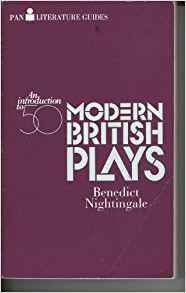| Generous Retrospective of Plays from 1902-1975 |
Theatre History |
| Benedict Nightingale “An Introduction to 50 Modern British Plays” , Pan Books , December 29, 2010 |
 Benedict Nightingale's eight page introduction to his “Introduction...” marries a lightness of step to a weighty sense of responsibility. The book was taken on easily, the true nature of the task's scale and challenge coming later. “The sheer fun of making a list appealed to me” he writes on first reaction. “If so, I was duly punished for my infantilism, because what followed was hard work and, of course, anxiety.”
Benedict Nightingale's eight page introduction to his “Introduction...” marries a lightness of step to a weighty sense of responsibility. The book was taken on easily, the true nature of the task's scale and challenge coming later. “The sheer fun of making a list appealed to me” he writes on first reaction. “If so, I was duly punished for my infantilism, because what followed was hard work and, of course, anxiety.”Lists comprise two categories. The “outs” can be as glaring as the “ins”. So, to the not-included: “Out of these and other agonies a compromise list eventually emerged.” Those from a first selection which were to go included Henry Arthur Jones, Rodney Ackland, Emlyn Williams, Auden and Isherwood, Joan Littlewood, David Mercer, Charles Wood, Heathcote Williams. If the book does anything it is reminder of a theatre culture of abundance. Pinero, Hankin, St John Ervine, Simon Gray, Peter Shaffer all knocked for entry to be among the 50. Of course Ireland dominates. No Shaw, Synge, O'Casey, Joyce, Behan, Beckett and the book, in the view of its author, would not be worth writing. Nightingale's introduction also sketches the shifts of the century preceding. In 1828, after the New Brunswick Theatre collapsed with lethal effect, a sermon could be preached against the iniquities of the whole activity. By 1895 Irving was in receipt of a knighthood. As for theatre's subject matter H A Jones in 1885 observed “by humble deference to everybody's prejudice we have banished from the stage all treatment of grave subjects, but what is commonplace and cursory and conventional.” He called for “perfect freedom of choice of subject, persons, place and mode of treatment.” Seven years later “Widowers' Houses” was on the stage, William Archer its collaborator and critical champion against theatre's insipidity. But it was a halting process. Of this selection just five come from the two decades 1930-1950 and Bridie, Eliot and Fry are not beacons of modernity. Tastes change. Or rather: “Perspectives shift; judgements of contemporary work are notoriously unreliable; and posterity will, of course, have its own interests, biases and axes to grind. Thirty years ago, Ustinov, MacDougal and Ronald Duncan would probably have been in this book.” Nightingale's critical approach stretches in the direction of generosity. The earliest play is J M Barrie's “the Admirable Crichton” of 1905. It is unlikely to be ever seen again. Its virtue, in the Nightingale view, is that “it offers us different horizons and reminds us of possible alternatives.” The last play is “Comedians” of 1975, which might be seen again, although more likely the nature of the jokes will inhibit it. Its purpose is humour itself. “It wants us to ask ourselves what we are laughing at, and why.” The comedies are fewer in number than the dramas in the pages that precede “Comedians.” Comedy is bonded by logic. By the time “Hobson's Choice” (1916) has been critically dismantled it does not emerge too well. “Rookery Nook” (1926) comes off better. “The voice of Ben Travers: spirited, mischievous, funny.” There is a vault through the decades until Joe Orton. Along with the dramatists he is tussling with the Lord High Chamberlain in his last years of censorship. Nightingale sees the limitations in “Loot” to be “not a lot more than a display of clever prankishness, entertaining mischief, very characteristic of the youthful decade to which it belonged.” By contrast “Jumpers”, a play of frantic rewrites throughout rehearsal, has a theme of Stoppardian seriousness. It wonders whether “social morality is simply a conditioned response to history and environment or whether moral sanctions obey an absolute, intuitive God-given law.” Murder and acrobatics help the seriousness of theme along considerably. Around 15 or so of the 50 are firmly lodged in the canon and likely to be seen afresh by new audiences. Many of the plays here by former names of lustre are likely to stay on the page. The verdicts are kind. Of “The Lady's Not for Burning” “today it may be most interesting as a poetic experiment and a period romance; but it contains moments when that light does glitter, that dance allure.” John Whiting's “Saint's Day” was bitterly attacked in 1951. Nightingale still views it as akin to Pinter. “It gives shape to suspicions, fears, and horrors likely to be found in many more subconsciousnesses than that of its author.” So much in theatre has changed. David Storey's “the Contractor” was a high water-mark of naturalism. It prompts a rare occasion for writerly musing over critical judgement. “Isn't all human achievement transitory anyway? The situation is ambiguous, and to insist on any single interpretation would, as Storey himself suggests, be to shrink a play that is moving, funny, humane and resonant. “Humane and resonant”- not bad adjectives for a book replete in experience and wisdom. There is a lot in these 455 pages which come with an excellent index and eight page bibliography. |
Reviewed by: Adam Somerset |
This review has been read 1387 times There are 31 other reviews of productions with this title in our database:
|
